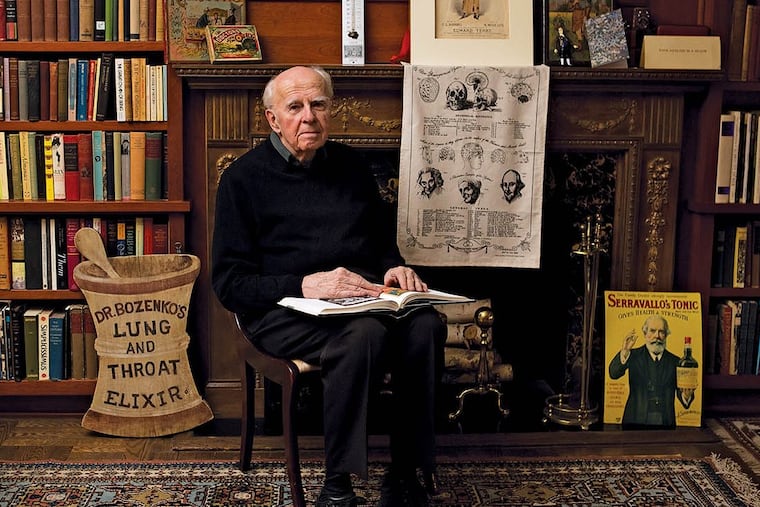William Helfand, 92, collector and authority on medical quacks
He donated more than 2,000 pieces to Philadelphia Museum of Art.

William H. Helfand, 92, an authority on the history of medical quackery who donated a substantial portion of his collection of quackery art and ephemera to the Philadelphia Museum of Art, died from heart failure Tuesday, Oct. 2, at Connecticut Hospice in Branford, Conn.
"Quackery is not the oldest profession. We know what is the oldest profession. But it's probably the second-oldest profession," Mr. Helfand said in a 2014 interview that covered topics such as the snake-oil salesmen and traveling medicine shows of the 19th and early 20th centuries.
The promise of elixirs and cure-alls still captivates, Mr. Helfand said, calling the modern TV infomercial "quackery in its purest form. It's whatever they can get away with at 4 a.m."
A Philadelphia native and retired pharmaceutical executive, Mr. Helfand donated more than 2,000 works to the Philadelphia Museum of Art, where he was a member of the Advisory Committee for Prints, Drawings, and Photographs from its formation in 1967 until 2014. He also donated approximately 1,000 books, pamphlets, and advertisements to the Library Company of Philadelphia.
"My father was unusual as a collector because he was so generous. He wrote about his collections, exhibited them, and eventually gave most of them away because he believed they should be used, learned from, appreciated — and seen," said daughter Jessica Helfand.
Mr. Helfand was the author of five books, including Quack, Quack, Quack: The Sellers of Nostrums in Prints, Posters, Ephemera & Books, which accompanied a 2005 exhibit of the same name at the Art Museum.
"Bill Helfand was the picture of an ideal combination of passionate collector, inquisitive scholar, and generous donor whose commitment continues to serve as a model for others," said Timothy Rub, the Art Museum's CEO and George D. Widener Director.
William Hirsh Helfand was born in Philadelphia and grew up in West Oak Lane, the oldest of three children to Minnie and Leopold Helfand, a pharmacist with a drugstore at Broad Street and Chelten Avenue. His mother sometimes played piano with opera singer Marian Anderson, his daughter said.
Mr. Helfand graduated from Central High School in 1943. He served for two years in the U.S. Army, then earned a bachelor's degree in chemical engineering from the University of Pennsylvania in 1948, and a degree in pharmacy from the Philadelphia College of Pharmacy and Science in 1952.
Mr. Helfand spent 33 years working for Merck, the pharmaceutical giant, including as president of its French division from 1970 to 1974. He was a senior vice president of the international division when he retired in 1987.
In a 2010 interview, Mr. Helfand said he began collecting after taking an art course at the Barnes Foundation while studying pharmacy. A few years later, he made his first acquisition of medical-related art: a 1772 British caricature of a military pharmacist. The piece was called The Chymical Macaroni.
"My father always credited his fascination with the visual world to Dr. Barnes, and to his studies at the Barnes Foundation when he was a young man," Mr. Helfand's daughter said. "Like [Albert] Barnes, he went to Central High School and trained as a chemist. Perhaps this gave him a sense of greater purpose, or maybe it just reinforced an essential drive that was always there, the desire to combine intellectual curiosity with visual ideas."
Besides his contributions in Philadelphia, Mr. Helfand was a benefactor to the New York Academy of Medicine, the medical library at Yale University, and the Huntingdon Library in California.
His wife, Audrey, whom he married in 1954, died in 2002.
In addition to his daughter Jessica, Mr. Helfand is survived by another daughter, Rachel Frankel; four grandchildren; and a sister, Joan Lusen.
The funeral will be private and a memorial service is planned for the end of the year.
Contributions in his name may be made to the Library Company of Philadelphia at https://bit.ly/2E3JhZY.